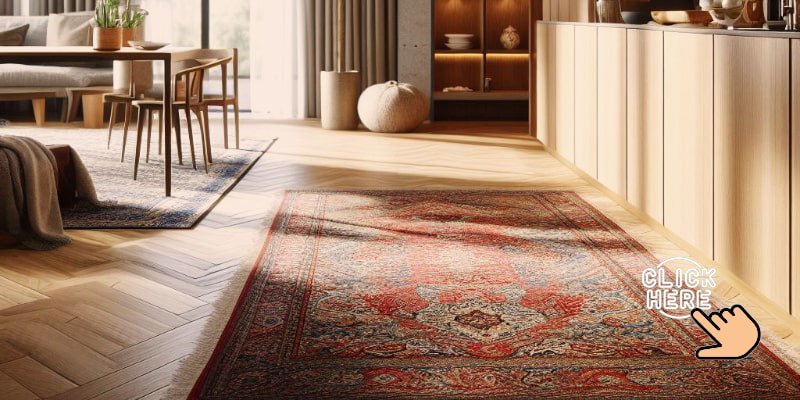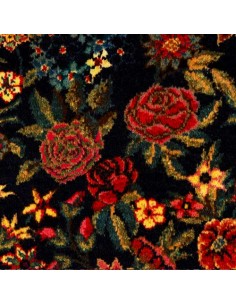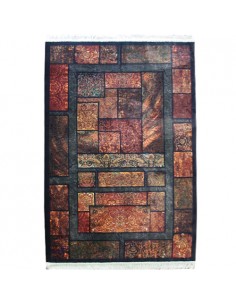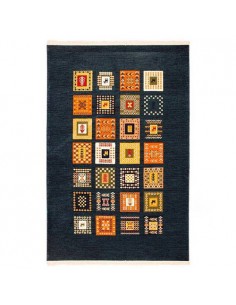- Mahsa S. Y.
- Interior Design
- 1241 views
- 2 comments
There are various types of floorings for home interiors, each with particular appearance details, lifetime, and maintenance requirements. For example, there are Carpets, Vinyl, Laminate, etc., with different designs, such as herringbone flooring or marble flooring. Choosing the right flooring for a home implicates the space's functional and aesthetic aspects. Here's an overview of different flooring types for various interior design styles, along with some tips and prevalent ideas for perfect flooring.
Decorating the home flooring is as important as choosing the right type for your home. So, while introducing the various kinds of home flooring options, we tell you how to decorate each on with the proper rug choice.
Carpet Flooring for Home Interiors
Home carpet is a velvety and cushy flooring type that adds warmth and coziness to interiors. Carpet flooring for home interiors suits the best for bedrooms, living rooms, and commercial interior spaces. The producers make carpets from various threads, including nylon, polyester, wool, and polypropylene.
Carpet Floorings come in different styles, patterns, and colors. Plush, Berber, and cut-pile are common carpet styles to consider. Recently, small carpets in tile sizes, known as carpet tiles, are getting more and more trendy.
Carpet Tiles
Carpet tiles, also known as carpet squares or modular carpets, are a distinctive form of carpet flooring in tiny dimensions. Unlike traditional broadloom carpet rolls, carpet tiles are tinier, typically square or rectangular pieces, often measuring 18" by 18" or 24" by 24".

Carpet Tiles Varieties
Carpet tiles come in various types, the most popular of which are:
- Peel-and-Stick Carpet Tiles: These have an adhesive backing for simple DIY installation. One of their frequent usages is in residential settings.
- Modular Carpet Tiles: These offer various patterns and color options, allowing you to be creative with your floor design.
- Eco-Friendly Carpet Tiles: Made from sustainable materials, these tiles are environmentally conscious choices for those who want to reduce their carbon footprint.
Still, remember that these are only three types of numerous varieties of carpet tiles.
Carpet tiles are one of the best options for bedrooms, but it is better to use a rug on them to make the bedroom warmer and cozier.
Here is "How to Choose a rug for a Queen Bed" in your bedroom.
Carpet Flooring Tips
Here are handy tips to apply carpet flooring correctly:
- Carpets are better for being used in Traditional, Vintage, Retro, Classic, Bohemian, Victorian, and Eclectic home interior design styles.
- Use complementary or contrasting tunes to depict distinct zones within an open-concept area.
- For upkeeping, do regular vacuuming and infrequent cleaning.
As you see, carpet flooring maintenance is leisurely and it is captivating at the same time. If you need help choosing a carpet color, here is the "How to Choose the Best Carpet Color" blog post.
Vinyl Flooring
Vinyl flooring is so versatile that it can suit various interior design styles. Vinyl's affordability, durability, and handy maintenance tips make sheet vinyl flooring and herringbone vinyl flooring flawless choices for many home interiors.
Vinyl floor tiles' raw materials are synthetic, mainly PVC (polyvinyl chloride), and can mimic the look of diverse other flooring materials, such as hardwood, tile, or stone.
Choose a stunning area rug to professionally decorate a room with vinyl flooring.
Types of Vinyl Floorings
Luxury Vinyl Tile (LVT) and Karndean Flooring are two popular types of vinyl. Vinyl Flooring includes some advantages like water resistance and disadvantages like being susceptible to damage; actually, every other type of flooring has its characteristics. If you are interested in vinyl floorings, read it in detail in the "Vinyl Flooring Complete Review" blog post. In that article, you can find the answers to all your questions about vinyl flooring, like "How to Design with Vinyl Flooring?" and so on.
You can use woven rugs for decorating with vinyl flooring; by clicking the following picture, you can visit Persian handwoven rugs.
Laminate Flooring
Laminate flooring is the other popular type of interior flooring that comes in various kinds. Laminate is cost-effective flooring and simulates the countenance of natural materials, such as wood or stone, using a high-resolution photographic coating layer. The producers make it with four layers, including the base, a fiberboard core, a photographic design layer, and a protective wear layer.
Laminate flooring is a reasonable and low-maintenance alternative to more costly materials. Its versatile designs, such as herringbone laminate flooring and durability, make it popular for those seeking the look of wood, tile, or stone without the high cost and maintenance conditions.
For a laminate floored living room, you can use 12*9, 4*6, and 5*8 rugs suited for the space floor plan. The picture below contains a link to a collection of 6*9 Persian rugs.
Floor Tiles
Tiles are versatile and available in ceramic, porcelain, and natural stone options. They can be arranged creatively to produce intricate patterns and designs, like herringbone floor tile. Floor design tiles come in a variety of sizes, colors, patterns, and textures, making them a versatile choice for interior design.
Cyrus Crafts; Luxury & Unique Products
Types of Floor Tiles
There are numerous types of floor tiles, including ceramic tiles, porcelain tiles, vinyl floor tiles, terrazzo tiles, etc. Here are the most popular ones in brief:
- Ceramic Tiles: Their raw material is clay; the clay is then fired at high temperatures, making them durable and water-resistant. They are typically proper for being used as bathroom floor tiles wall or floor tiles for kitchens and lobbies.
- Porcelain Tiles: Upgrade your space with porcelain tiles, the ultimate choice for durability and longevity. Experience the superior quality of ceramic tiles that are denser and stronger. They are suitable for both interior and outdoor spaces.
- Natural Stone Tiles: These are made from quarried gravel, such as marble, granite, travertine, and slate. They contribute a striking and lifelike look but may need more upkeeping tips. Marble floor tiles are so trendy these days.
- Terracotta Tiles: Terracotta tiles are unglazed clay tiles that present a rural and soil-like formation. They are suitable for Mediterranean and rustic interior styles.
- Mosaic Tiles: Mosaics are miniature tiles of various materials, mainly used to create intricate patterns or designs on floors.
Floor tiles are favored for their versatile options, making them proper to be used in different areas. Tiles are highly durable and suitable for areas prone to moisture, like kitchens and bathrooms. Grout maintenance is essential for all kinds of tiles.
The tile's material, size, and design can exceptionally affect the prevailing aesthetics of a space. The durability feature makes floor tiles a suitable choice for rooms that see heavy foot traffic or moisture exposure.
Floor tiles are ideal for Mediterranean, Bohemian, Art-Deco, and Contemporary interiors.
Don't use huge rugs on the floor tiles; you can choose a 4*7, 4*6, or 3*5 rug for the top of the room tiles as the flooring. Click the picture below to visit Iranian 4*6 rugs.
Epoxy Flooring
Epoxy is a type of flooring that includes multiple layers of epoxy resin applied to a concrete or equivalent substrate to form a long-lasting, benign, and chemical-resistant floor. It's generally used in public places, such as garages and hospitals, due to its exceptional strength and durability. Still, it's also gaining popularity in residential applications, especially home garages and home gym flooring.
Moreover, as epoxy flooring can come in various designs, such as coastal or abstract countenances, it is getting more and more trendy for home interiors. There is a complete guide on "Epoxy Floor Coating" in CyrusCrafts magazine for you to read more about this interior flooring type.
Because of being unlimited in designs, epoxy floor coatings are proper for almost all types of interior designs; still, it is best for industrial styles. Still, preferably, they are best for Contemporary, Modern, Coastal, Scandinavian, and Eclectic styles.
Polyaspartic Flooring
Polyaspartic is a mixed material resembling polyurethane. It is a mix of ester and other materials, which is an alternative to epoxy and is an aliphatic polyurea sealer. It is ideal for garages, basements, home gym flooring, and industrial home interiors.
Producers can adjust the amount of ester to customize polyaspartic to have distinct traits, such as quick drying times and limited gas emissions after application. This feature makes it more versatile than epoxy. Nevertheless, it is more expensive than epoxy, too.
Hardwood Flooring
Hardwood flooring is so timeless that it makes it a lovely option for homes and commercial places. Hardwood flooring maintains multiple advantages, such as durability, aesthetics, and easy maintenance tips. Hardwood floors bring timeless beauty to any space. Oak, maple, cherry, and walnut are popular wood species, each offering its unique grain pattern and color variations.
If your bedroom flooring is hardwood, you need a rug for under your bed. Here is a complete guide to choosing a rug for a king-size bed.
Hardwood Flooring Applications
Hardwood flooring, such as herringbone wood floor, is suitable for Classic, Neoclassical, Eclectic, Bohemian, Rustic, Mid-Century, Farmhouse, Traditional, Cottage, Hamptons, Retro, and almost all home interior design styles. When it comes to picking the right hardwood flooring for your home or business, it can seem overwhelming. It's essential to keep in mind your budget, lifestyle, and the unique needs of the setting.
Vintage-style rugs, such as Kilims, are the most proper rugs for decorating hardwood floorings. If you want to see various vintage rugs, click the following picture.
Linoleum Flooring
Linoleum flooring is a resilient material made of genuine and renewable materials, principally linseed grease, cork or lumber flour, and jute. It is eco-friendly and sustainable because it is formulated of organic and biodegradable ingredients. For over a century, linoleum flooring has been valued for its durability, versatility, and low maintenance requirements.
Linoleum Flooring Key Features
Here are some critical characteristics of linoleum flooring:
- Sustainability: Linoleum is made from renewable materials, making it an environmentally friendly flooring option. Its production process has minimal environmental impact.
- Durability: Linoleum is a durable material with a long lifetime that can resist weighty traffic.
- Wide Colors and Designs Range: Linoleum comes in a variety of colors and designs, including solid tints, marbled designs, detailed patterns, etc. It allows you to be creative and customize your flooring order.
- Comfort and Warmth: Linoleum has a natural cushioning effect, providing a comfortable underfoot feel. It also maintains a relatively warm temperature, making it more comfortable in cold climates.
- Resilience: It has some degree of natural bounce, which reduces fatigue for those who stand on it for extended periods, making it a popular choice for kitchens and healthcare facilities.
- Low Maintenance: Linoleum is easy to clean with regular sweeping and damp mopping. Periodic resealing can help maintain its appearance.
- Hypoallergenic: Linoleum is less likely to trap allergens, dust mites, or mold, making it suitable for people with allergies.
Linoleum Flooring Common Usages
- Kitchens: Linoleum is a popular choice for kitchen flooring due to its comfort, durability, and resistance to spills and stains.
- Bathrooms: Linoleum is resistant to moisture and easy to clean. It makes linoleum a fortunate option for bathrooms.
- Residential Areas: Linoleum is usable in diverse residential spaces, such as bedrooms, living rooms, and hallways, for it offers a range of design possibilities.
As kitchen floors have the potential to get dirty frequently, it is better to use a cheap rug on the kitchen flooring and wash it regularly. Here is a guide for affordable rugs.
Linoleum Flooring Installation Process
The installation of linoleum flooring typically involves the following steps:
- Subfloor Preparation: The existing subfloor is prepared, which may involve cleaning, leveling, and ensuring it is dry and free of imperfections.
- Adhesive Application: A suitable adhesive is applied to the subfloor, and the linoleum sheets or tiles are carefully laid down, ensuring a smooth and secure fit.
- Seaming and Cutting: It is crucial to have precise cutting when creating seams to join linoleum sheets to ensure a perfect fit in the room.
- Rolling and Securing: Once the linoleum has been installed, the adhesive is rolled into the adhesive, and the subfloor is secured with a heavy roller.
- Trimming and Finishing: Excess material is trimmed away, and any necessary transitions or moldings are installed for a clean and finished look.
Linoleum flooring offers a wide range of design options with a low environmental impact. It is suitable for almost all interior design styles. A versatile floor design covering all styles of interior design, it is long-lasting, comfortable underfoot, and easy to maintain.
Parquet Flooring
Parquet is a classification of wood flooring that is well known because of its unique and refined geometric designs. Parquet flooring is composed of miniature pieces of wood arranged in a repeating pattern. This way, they create a visually attractive complex countenance.
Parquet Flooring Characteristics
Parquet flooring is the perfect choice for those who appreciate classic design elements and want to achieve a sophisticated look. So it is perfect for Classic, Neoclassical, Contemporary, Art Deco, and modern interiors.
It offers a timeless and luxurious aesthetic that adds warmth, character, and visual interest to various interior spaces. With its unmatched beauty and durability, parquet flooring is a confident choice for creating a sophisticated and inviting atmosphere in all interior design and decoration styles.
The silk rugs that you see by clicking the following picture are the best options for being used on top of parquet floorings.
SPC Flooring
SPC flooring, also known as Stone Plastic Composite flooring, is a highly durable and versatile type of engineered flooring that has gained immense popularity in recent years. SPC flooring is widely used in both residential and commercial spaces due to its exceptional durability and versatility.
SPC Flooring Usages
SPC flooring is an excellent option for home interiors due to its unrivaled durability, imperviousness to humidity, and uncanny ability to resemble natural materials closely. Its versatility and low-maintenance tips nature make it an ideal flooring choice for a wide range of interior design styles such as Modern, Neoclassical, Classical, Industrial, Farmhouse, Mid-Century, Mediterranean, etc.
Remember that the SPC floorings absolutely need an area rug, so choose a suitable rug size for decorating it. Clicking on the following picture takes you to the collection of CyrusCrafts' 4*7 rugs.
Concrete Flooring
Concrete flooring contains concrete as the primary material for both bare and finished surfaces. Concrete floors are so popular because of their durability and industrial aesthetic.
Concrete flooring is enduring and needs minor maintenance. The decorative options make it suitable for various home interior styles, such as Minimalist, Industrial, Modern, Neoclassical, Eclectic, Gothic, Bohemian, Contemporary, and Hybrid designs.
Bamboo Flooring
Bamboo flooring comes from bamboo, a quickly renewable and endurable resource. Bamboo is known for its eco-friendliness and unique appearance. Bamboo flooring is made in various styles and colors that make it fit a broad range of interior design styles. Here's an overview of bamboo flooring's key features and installation steps.
Key Features of Bamboo Flooring
As a popular type of interior flooring, bamboo has some attractive vital features. The boldest ones are briefly introduced in the following:
- Sustainability: Bamboo is one of the fastest-growing plants on Earth. It is considered approvingly sustainable and robust. Bamboo matures in only a few years, making it an environmentally friendly flooring for interiors.
- Durability: You may not know that bamboo is a durable material for being used as flooring. It can be as durable as traditional hardwoods like oak and maple.
- Appearance: Bamboo flooring typically has a distinctive grain pattern and appearance, which can range from light and natural to darker, stained colors. It can be found in both solid and engineered forms.
- Easy Maintenance: Bamboo floors are easy to clean and maintain. Routine sweeping and infrequent damp mopping are usually okay.
- Hypoallergenic: Bamboo floors do not trap allergens like carpet can, making them suitable for those with allergies.
- Versatility: Bamboo flooring is available in various styles, including vertical or horizontal grain patterns, strand-woven, and stained options.
You can use a 5*7 area rug on your bamboo flooring to improve it.
Bamboo Flooring Installation Steps
The installation of bamboo flooring typically involves the following steps:
- Subfloor Preparation: The subfloor must be clean, level, and dry to ensure a stable and durable installation.
- Acclimatization: Bamboo planks should be allowed to acclimate to the room's humidity and temperature for some time before installation.
- Adhesive or Fastening: Bamboo can be installed using adhesive, nails, or a floating floor method, depending on the type of bamboo flooring chosen.
- Finishing: Some bamboo flooring comes prefinished, while others require on-site finishing. The finish provides protection and enhances the appearance.
After all, bamboo is eco-friendly and durable but can be susceptible to moisture. It's an ideal option for bedrooms and living rooms. You can use it in Modern, Classic, Contemporary, Eclectic, Bohemian, Cottage, Neoclassical, and Hamptons Style House Interiors.
Cork Flooring
Cork flooring is undoubtedly one of the best flooring options available out there, thanks to its durability, eco-friendliness, and unique properties that make it stand out from the rest. This versatile flooring material is made from the bark of cork oak trees and is guaranteed to provide you with a long-lasting and sustainable flooring solution. It is known for its unique appearance, natural cushioning, and eco-friendliness. Cork flooring has gained popularity due to its sustainability and many desirable qualities. Here's an overview of cork flooring:
Cork Flooring Features
Here are the boldest features of cork flooring:
- Sustainability: Cork is a renewable resource, as it is harvested from the bark of cork oak trees without harming the tree itself. I make it an environmentally friendly flooring option.
- Insulation: Cork's exceptional thermal and acoustic insulation properties make it an energy-efficient and highly effective material for reducing noise.
- Hypoallergenic: Cork flooring does not trap allergens like carpet can, and it makes it suitable for people with allergies.
- Appearance: Cork flooring has a unique and natural look with a distinctive grain pattern. It is available in various styles and colors.
- Interior Design Styles: Great for Farmhouse, Cottage, Bohemian, and Rustic design interiors.
Use a large size, such as a 9*12 area rug on the cork flooring, in your home interior to make it more welcoming.
Uses of Cork Flooring
The cork flooring is best for being used in:
- Residential Spaces: Cork flooring is often used in bedrooms, living rooms, kitchens, and home offices due to its comfort and durability.
- Commercial Spaces: It can be found in commercial settings such as offices, retail stores, and restaurants for its durability and sound-absorbing properties.
- Specialty Applications: Cork is also used in libraries, recording studios, and spaces where noise reduction and comfort are essential.
Cork Flooring Installation
Installing cork flooring implicates the following steps:
- Subfloor Preparation: The subfloor should be clean, level, and dry. A moisture barrier may be necessary to prevent moisture from reaching the cork.
- Acclimatization: Cork tiles or planks should be allowed to acclimate to the room's humidity and temperature for a period before installation.
- Adhesive or Floating Installation: Cork can be installed using adhesive or as a floating floor, where planks or tiles lock together without the need for glue.
- Finishing: Some cork flooring comes prefinished, while others require on-site finishing. The finish provides protection and enhances the appearance.
Cork flooring offers an eco-friendly, comfortable, and unique flooring option. Its natural cushioning and insulation properties make it a popular choice for various interior spaces, and its sustainability adds to its appeal in environmentally conscious designs.
Cork flooring is soft and warm, making it perfect for bedrooms with a, for example, 8*10 area rug. It requires proper sealing to prevent damage from moisture.

After all, you can separate your home interior spaces by applying different floorings. The only point you'd better consider is to match them carefully in a logical harmony. Choosing the right flooring should align with the specific needs of each room, your design preferences, and your budget. Maintenance and lifestyle considerations are essential for long-term satisfaction. Additionally, incorporating area rugs and carpets can enhance your chosen flooring while adding a personal touch to your home's interior design.
For home interiors, rugs are the best flooring ornaments. You can use rugs on all types of floor designs. CyrusCrafts offers various types and designs of Persian woven rugs in bulk at the best prices with shipping to all around the world. To order your favorite Persian rug, fill out its order form and wait for us to deliver it to your address quickly. For Canada and the USA residents, the delivery time is so fast.
































Comments (2)